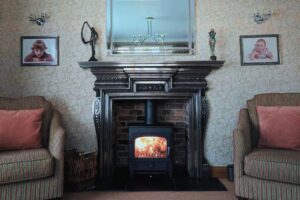While a baseboard heater provides comfort during the cold season, it is an eyesore that lessens the beauty of your home. Can a baseboard cover help? I will tell you things about wood baseboard heater covers – what you need to know.
A baseboard cover fits neatly around the baseboard heater and its vents. It improves the visual appeal of the area where the heater is installed. This cover is not an optional thing. So, it is good to match it with the décor on your wall. It will add a more polished and smoother look to the room.
While wooden covers offer safety, they can reduce the heating efficiency of the baseboard heater. Wood can serve as insulation because it absorbs heat. They often retain heat instead of reflecting and distributing it around the room. The better cover material is steel.
Read on to learn more about wooden baseboard heater covers, other baseboard cover options, and how to make a wooden baseboard cover.
Wood Baseboard Heater Covers

Decorate the Spot Where the Heater Is
Baseboard heater covers fit neatly around baseboard heaters and their vents. They add a visual appeal and decorate the spot where the heater is. These covers should not be optional, but they need to be painted to match the décor of the walls in the home. This will give the baseboard area a more polished and smoother look.
Metal Is a Better Cover Material
While heater covers made of wood offer safety, they are not that heat efficient. Wood can serve as insulation that blocks the radiation of heat. It absorbs heat instead of reflecting it around the room. A better cover material to use is metal or steel.
Decorate with Wood
In reality, most baseboard heater covers are made of metal. So, if you want to make a wooden baseboard heater cover more visually appealing, you can decorate it with wood. Or you can box the heating elements with decorative wood while leaving the spaces around the front of the heater open so that heat can escape into the room.
Don’t Cover the Lower Portion of the Baseboard Heater
You shouldn’t cover the lower portion of the baseboard heater. If you cover it, the heater will stop working because there will be no airflow. This type of heater only works if the air is allowed to circulate. So, if you block the flow of air in or out, you are practically turning off the heater.
Factors to Consider Before Using Wood Baseboard Heater Covers
1. Safety
You might be thinking of covering the baseboard heater because of safety reasons. Perhaps you have a baby who is starting to crawl, and it may venture into the heater and get burned. The obvious solution is to cover the heater with something.
2. Installation
You are strictly prohibited from covering the lower portion of the baseboard heater. But you can still ensure the safety of your smaller family members by using a heater cover properly. The way you install the cover should not impede the ability of the heater to radiate heat inside the room.
3. Enable the Heater to Fully Operate
Any covering that you will use should still allow the heater to operate to its full capacity while protecting yourself, your family, and the furniture and other things around the room from the hot searing temperature of the heater’s heating elements.
Which Is Better, Wood, Plastic or Metal Heater Cover?
If you are thinking of improving the looks of your baseboard heater, you have several options. You can either cover it with wood, plastic, or metal. Which of these materials is the better option? This is what I will now discuss with you.
As you well know, your baseboard heater has mostly metal as a material since metal is a good heat conductor. Meanwhile, wood and plastic fall behind metal in these areas.
1. Heat Conductivity
Metal conducts heat better than wood or plastic. All materials have a heat property that is called thermal conductivity. This term refers to the amount of heat transferred through a unit thickness of a certain material. Thermal conductivity has Watts per meter Kelvin (W/m-K) as its unit.
A higher number means better thermal conductivity. The numbers below will help you compare the thermal conductivity of plastic, wood, and metal:
- Polymer plastic = 0.25 W/mK
- Wood = 0.15 W/mK
- Metal = 43.0 W/mK
As you can see, metal has the highest thermal conductivity. This means it is the best material you can use to cover a baseboard heater because it won’t impede the heater’s ability to radiate heat.
The high conductivity of metal is the primary reason manufacturers did not change the materials used to make cast iron radiators. Iron is a kind of metal. It holds, retains, and radiates heat effectively more than wood and plastic.
2. Moisture Retention
Ordinary metals corrode. That means somehow they also retain moisture. But not as much as how wood retains moisture. Plastic is the material that completely repels moisture. So, in this regard, plastic is better than metal or wood.
However, this should not be the only factor you need to consider when choosing a material you will use to make baseboard heater covers.
At any rate, metal takes the upper hand in this matter because it does not retain moisture as much as wood. So, when used as a baseboard heater cover, it will last longer than wood and plastic. In the presence of moisture, wood can warp, crack, or split into pieces. Plastic tends to crack, split, or turn into powder as it grows old.
3. Melting Point
Metal has the highest melting point compared to metal and plastic. Plastic will melt easily if subjected to heat. Wood will combust if subjected to sufficient heat. It will take furnace temperature before metal melts. In this regard, metal is the strongest material you can use for making baseboard heater covers.
Again, what are wooden baseboard heater covers? The wooden baseboard heater covers make your old baseboard heater visually appealing while allowing the heat to escape towards the room.
Why Steel Is the Best Material for Baseboard Heater Covers

Efficiently Conducts Heat Energy
It is worth repeating that steel or metal is the best material for making baseboard heater covers. Metal efficiently conducts heat energy, much better than plastic or wood. Considering the heating process and how every part of the heating system works, you will better appreciate why steel is the best material.
How Does Baseboard Heating Work?
Baseboard heating or finned tube element heating uses the same heating system used by bigger cast iron radiators which operate on convection and radiant heating concepts.
When the thermostat senses that the temperature is going down, it signals the boiler to turn on. As the boiler runs, it heats the water inside its tubes. Then this heated water flows to the heat emitters inside the heating loop.
The air currents that move slowly inside the room will contact the fins or heating elements, and the air gets warmer. This warm air will rise and eventually cool down and settle on the floor. It will again contact the fins, and the whole cycle repeats.
When the thermostat senses that the right (comfortable) temperature has been reached, it will signal the boiler to shut off. The flow of heated water will stop, and it will cool down. This is when the steel near the emitter makes a big difference.
Great at Conducting and Retaining Heat
Since steel is great at conducting and retaining heat, it will keep the room warm. It will help retain the warm temperature of the air inside the room for a certain period – until the actual temperature goes down. This reduces the energy needed to warm the room. It is an ability that wood or plastic baseboard covers don’t have.
Combine Wood and Metal to Improve Baseboard Heater’s Appearance
If you want to improve the looks of your baseboard heater, you can undoubtedly use wood. Finely crafted wood has been traditionally used as radiator enclosures. In that sense, wood is only used for aesthetic purposes.
However, since baseboard heating uses wafer-thin aluminum fins which cool down fast, it is wiser to use a metal cover. It will function as an adjunct heating element after the boiler shuts off for a certain period.
So, if you would like to improve the looks of your baseboard heater, you can combine wood and metal to create a sort of hybrid cover. Wood should be used purely to improve the appearance, while metal should be used as an extra heating element.
How to Make Wooden Baseboard Heater Cover

In making a baseboard heater cover made of wood, you need to prepare the following materials and tools:
Materials
- 1 wood front cover
- 1 wood top cover
- 2 wood end boards
- 2 wood support
- Table saw
- Tape measure
- Hammer
- Finishing nails
- Screwdriver
- Jigsaw
- 220-grit sandpaper
- Stain
- Vacuum
- Stud Finder
Procedure
- Use the measuring tape to measure the length of the baseboard heater. Leave the metal plate at the back for wall protection.
- Use the vacuum cleaner to clean out all the debris around the heater and its heating elements.
- Use the table saw to cut the wood end boards. They will be used as legs for the heater cover. You should cut it from 4 inches to 6 inches wide. They should also be as tall as necessary to sufficiently cover the heating elements.
- Use the jigsaw to cut two to three notches, each at 2 inches long, from the top of the end boards. This will enable heat to escape from the sides of the heater. Cut the top cover so that it will have the same length as the heating element.
- Use the hammer to nail the top cover to the end boards.
- Use the table saw to cut a 1-inch wide by 1-inch thick support board. Its length should approach the length of the heating elements but at least two inches shorter at the end.
- Use a stud finder and place it against the wall to find the studs.
- Use the hammer and get a nail and nail the support board into the wall studs above the metal plate at the back of the heater.
- Get the wood top and end boards and attach them to the support board which is against the wall.
- Use the table saw to cut the second support board. This will enable you to attach it at the middle of the wood top. It will act as means of support to the front cover.
- Use the table saw to cut the front cover to its required length. Use the tape measure to measure the height so that it can reach the wood cover. Then cut out 4 inches from the wood.
- Nail the front cover to the support wood and the end boards. Leave 2 inches of space at the top.
- When all is done, you will have a wood cover that has openings at the top and bottom. This will allow heat inside the cover to escape outside.
- Use 220-grit sandpaper to sand the wood until the surfaces are smooth.
- Finally, apply sufficient coats of wood stain. The stain will bring out the wood grains and will also seal the wood cover from moisture.
Wooden Baseboard Heater Cover Options
There are wooden covers for baseboard heaters that are available in the market. Buying one of them will save you the trouble of making one on your own.
Here are two baseboard heater covers that you can consider:
Décor Grates WL18BB Lattice Baseboard Floor Register
This baseboard heater cover is made of oak with a natural finish. The Décor Grates WL18BB Lattice Baseboard Floor Register is made for long, trouble-free operation. It is also easy to install.
18” Wooden Floor Baseboard Register
This 18-inch Wooden Floor Baseboard Register is made of beautiful red oak and is already pre-finished. It also comes with angled slots that can divert airflow in two directions.
Conclusion: Wood Baseboard Heater Covers
Baseboard covers fit comfortably around baseboard heaters and their vents. These covers improve the area’s visual appeal where the heaters are installed. Using a baseboard cover is not optional. So, it is best to match the baseboard cover with the room’s overall décor, so there’s harmony, and it’ll look more polished.
While you can use wooden covers, you need to understand that they tend to insulate rather than reflect heat. So, wooden covers may not circulate heat around the room. A better material to use is steel.
Related reading:
Cheapest Way to Insulate a Metal Building
Insulating Rim Joists [The Complete Guide]

![Hot Water Heater Is Only Lukewarm [Causes and How to Fix] hot water heater only lukewarm](https://homecarezen.com/wp-content/uploads/2021/04/hot-water-heater-only-lukewarm-150x150.jpg)
![Kerosene Heater for Garage [Tips and Best Heaters] Kerosene Heater for Garage](https://homecarezen.com/wp-content/uploads/2021/10/Kerosene-Heater-for-Garage-150x150.jpg)
![Kerosene Heater for Garage [Best Picks and Tips] Kerosene Heater for Garage](https://homecarezen.com/wp-content/uploads/2021/11/kerosene-heater-for-garage-150x150.jpg)


